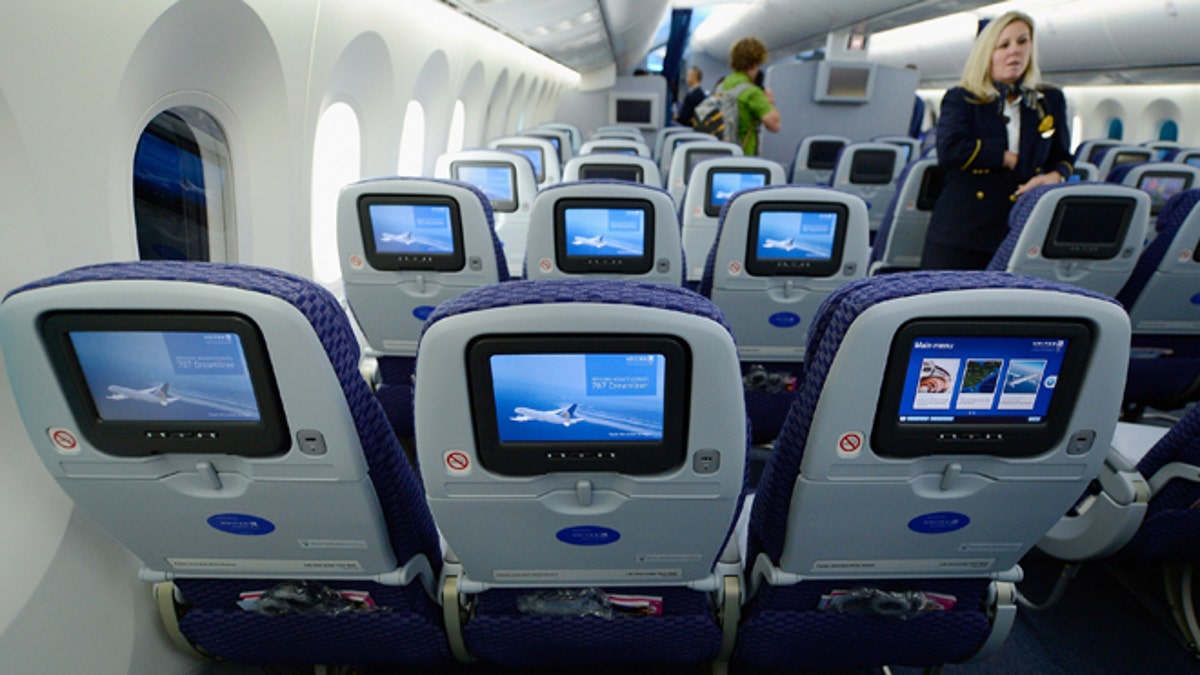
United Airlines flight attendant Tina looks at personal entertainment systems on the new Boeing 787 Dreamliner during a tour of the jet at Los Angeles International Airport on November 30, 2012 in Los Angeles, California. (Photo by Kevork Djansezian/Getty Images) (2012 Getty Images)
Frequent flyers who rely on their mobile phones can now say: Finally.
Well, they can at least claim a partial victory.
The Federal Aviation Administration said Thursday it will allow airlines to expand the use of electronic devices during takeoffs and landings on planes.
The change in government safety rules will let passengers read, work, play games, watch movies and listen to music — but not make calls. Electronic devices, however, must meet certain criteria for protecting aircraft systems from electronic interference.
Most new airliners are expected to meet the criteria, but changes won't happen immediately. Timing will depend upon the airline.
"Passengers will eventually be able to read e-books, play games, and watch videos on their devices during all phases of flight, with very limited exceptions," the FAA said Thursday.
The changes come following months of study by a group of aviation experts commissioned by the FAA.
Connections to the Internet to surf, exchange emails, text or download data will still be prohibited below 10,000 feet. Heavier devices like laptops will have to be stowed. Passengers will be told to switch their smartphones, tablets and other devices to airplane mode.
A travel industry group welcomed the changes, calling them common-sense accommodations for a traveling public now bristling with technology. "We're pleased the FAA recognizes that an enjoyable passenger experience is not incompatible with safety and security," said Roger Dow, CEO of the U.S. Travel Association.
Looser Rules, Major Changes
But looser rules for personal electronic devices or PED's are likely to force airlines to make some major changes, according to Reuters.
Carriers, for starters, will need to determine if their planes are "PED resistant" and able to tolerate the proposed broader use of electronics. Some smaller and older planes with less robust avionics may not be, calling for different procedures on device use.
Cabin crews will need new announcements, placards and ways to monitor broader use of such devices as Apple Inc iPads or Amazon.com Inc Kindles. Bulky devices such as laptops and DVD players will need to be stowed during takeoff and landing, and perhaps even when planes are taxiing for long periods to avoid blocking people in an evacuation.
Most importantly, on some landings in poor weather, passengers may still be required to shut down devices so they won't interfere with electronic guidance systems that planes rely on to locate the runway.
"It's not about certifying devices to be used on airplanes. It's about certifying airplanes to enable use of devices," said Douglas Johnson, a committee member and vice president of technology policy at the Consumer Electronics Association.
TRICKY QUESTIONS
For now, rules banning use of electronic devices below 10,000 feet remain in effect.
The new guidelines pose some tricky questions for air carriers. For example: How will cabin crews deliver safety announcements when passengers are plugged into their own devices?
" 'You have to get out of the plane because there's smoke' - What if you did not hear that?" said Captain Chuck Cook, a committee member and pilot who is manager of fleet programs and technology at JetBlue Airways.
Airlines also will need to harmonize their announcements and rules to avoid sowing confusion. Otherwise "passengers will start to create their own reality about what's allowed," Cook said.
Solutions devised for a large airline with modern jets might not work for a small carrier with propeller planes, he said. Accordingly, the report provides an outline to structure the FAA's thinking, and "the book is still waiting to be written" by the agency, Cook said.
"There are lots of ways to solve a problem, and we were careful to not say this is how to solve it," he said.
The guidelines cover technical changes such as how to ensure planes are resistant to electronic interference; changes to ensure they can operate safely with the devices; and changes in the ways attendants instruct passengers about using them appropriately.
Paul Misener, vice president for global public policy at Amazon.com, led the subcommittee on technical standards. He said the report, together with FAA guidance, will help airlines determine if their planes can tolerate greater electronics use.
"Aircraft have improved rather dramatically over the years" to resist electronic interference, Misener said. Today most are "immune to it" since they are designed to fly through radio beams from satellite dishes and broadcast towers.
Airlines will still look at the plane make, model and avionics systems to guarantee they can handle any stray signals from portable devices.
In some landings where visibility is low and guidance instruments are turned on, the portable devices may still need to be turned off to be cautious, but that would be in fewer than 1 percent of flights, said Misener, who is also an electrical engineer.
Now, airlines will need time to develop announcements, update manuals, train crews and inspect planes.
"You just can't turn that on in a day," said Cook.
Based on reporting by the Associated Press and Reuters.
